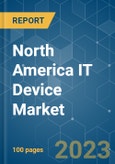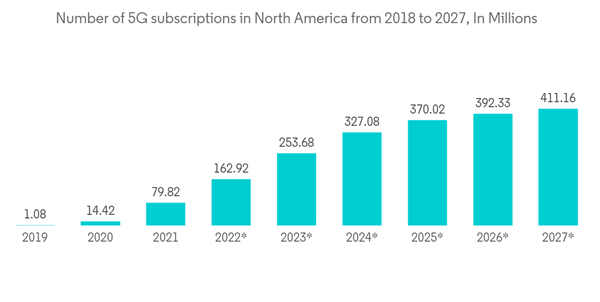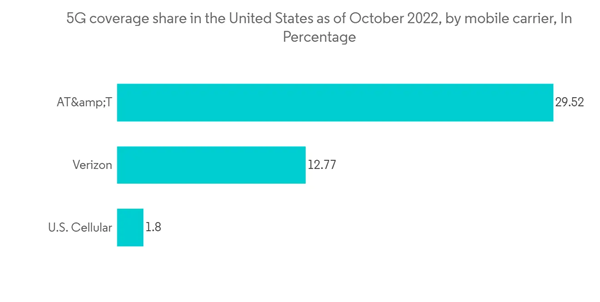The North American IT device market is expected to register a CAGR of 1.6% for the next five years. The growing laptop and mobile penetration is expected to boost the North American IT device market for the forecast period. Also, the purchasing power of the people in this region is a determinant of growth.
As per Ericsson, by 2027, North America is estimated to have approximately 411 million 5G subscribers. There were 80 million 5G subscriptions in North America last year.
In September 2022, Dell Technologies formed a strategic alliance with advanced video analytics firm Deep North. Dell and Deep North are advancing conventional retail analytics to assist companies in achieving their strategic business objectives by allowing shops, malls, and other commercial areas to better analyze customer behavior in the retail environment.
In June 2022, Google Cloud established a new subsidiary, 'Google Public Sector,' focusing on the US market. As a part of Google LLC, this new entity would focus on providing Google Cloud services to United States public sector clients, including Google Cloud Platform and Google Workspace.
This product will be delivered within 2 business days.
Key Highlights
- The disposable income of the United States is greater than that of any other country in the world. There is a chance for growth in the IT device sector in high-income countries. Furthermore, higher-income countries such as the United States and Canada are leading in the adoption of new, upgraded technologies and capacity ownership.
- The United States is in the lead when it comes to cloud adoption. Cloud usage will continue to increase over the next few years due to businesses' need for adaptable IT infrastructure to respond to market developments quickly. This increase in cloud usage would result in a surge in demand for mobile phones, laptops, and cloud-based services that support cloud-based applications.
- In the North American IT device industry, there was a significant mismatch between the supply and demand for chips or semiconductors, which started during the time of the COVID-19 pandemic. Smartphone and laptop manufacturers were impacted because of this shortage. One of the worst-hit corporations was Apple, the largest chip importer in the world, which delayed the release of the iPhone 12 last year.
- Moreover, the need for supercomputing platforms is rising quickly in the North American region, but more funds are needed to invest in technology. In the United States, there is an increasing demand for the computing capacity that supercomputers provide. Frontier, the United States-based supercomputer with a LINPACK benchmark score of 1.102 ExaFlop/s, is the quickest supercomputer on the TOP500 supercomputer list as of May this year. Fugaku is the next fastest supercomputer. Five of the top ten are owned by the United States; China owns two; and one each is owned by Japan, Finland, and France.
- Desktops, laptops, and workstations will continue to be impacted by component shortages and transportation issues through the end of the year. The U.S. market experienced its first dip since the pandemic's start. The transition to remote work and learning intensified purchasing. Still, after a year of acceleration, there has also been a comparative slowdown in PC expenditure, which has led to some softening of the United States PC market recently. The inclination of consumers to reduce luxury spending and concentrate on necessities due to the pandemic has also led to a fall in demand for premium-range smartphones. However, the market is gradually coming back on track.
North America IT Device Market Trends
Stellar Smart Phone Penetration
- In advanced economies like the United States and Canada, there is a significant demand for smartphones since urban populations are far more likely than rural ones to use cell phones. According to the GSMA, in North America, 329 million individuals, or approximately 84% of the population, were subscribers to mobile services last year. The expected number of subscribers by the end of 2025 is 341 million, or around 85% of the population.
- There were 303 million mobile internet users in 2021, which is expected to grow to 322 million in 2025. Mobile internet penetration in North America is expected to rise from 77% in the last year to 80% in 2025. The rapid penetration of mobile internet coverage across the region is a prime cause of the demand for smartphones in North America. By the end of the previous year, North America witnessed a smartphone penetration rate of 83%, which is expected to rise to 86% by 2025. Smartphones would represent, on average, over nine out of ten connections by 2025 in North America.
- Also, there would be an expected surge in the number of new SIM connections in North America, from 413 million last year to 431 million in 2025. The demand for new mobile devices can be forecasted in the next few years from the anticipated rise of new SIM connections. By 2025, North America's economic contribution from mobile will expand by USD 100 billion, mostly because of the continuous growth of the mobile ecosystem.
- According to GSMA Intelligence, 5G adoption is rapidly increasing in North America and is expected to take over the wireless services market by 2025. As per the report, North America had 14% 5G coverage last year, which is anticipated to reach 64% by the end of 2025. Several large smartphone manufacturers across the region are concentrating on releasing 5G devices to meet the rising demand for 5G-capable handsets from tech-aware customers. Demand for 5G-enabled devices is anticipated to rise in the region.
As per Ericsson, by 2027, North America is estimated to have approximately 411 million 5G subscribers. There were 80 million 5G subscriptions in North America last year.
United States Controls the Majority of Demand
- Rapid mobile broadband coverage across the United States is a significant driver of the rapid adoption of smartphones in the country. According to the GSMA report, smartphones accounted for 85% of mobile phone subscriptions in the United States over the last year, with tablets accounting for 83%.The country's mobile phone market is expected to grow with a robust smartphone adoption rate. As per the reports, mobile subscriber penetration in the country is expected to reach around 86% by 2025, with a smartphone adoption rate as high as 85%.
- In terms of 5G adoption, the United States is among the top countries in the world, resulting from operators' aggressive 5G implementation plans and a booming ecosystem of devices and content. By 2025, the United States is expected to have 68% 5G coverage. This would contribute to the shift in people's demand from basic smartphones to IoT and 5G-enabled smartphones, thereby changing the entire mobile ecosystem.
- As of September this year, Apple had the largest smartphone market share of 55.4% in the United States. The company itself makes more than half of all cell phones sold on the market. Samsung is far behind Apple in terms of market share. Its market share of 30.11 percent is 25.34 percent less than Apple's.With 4.93% of the smartphone market, Motorola is in third place, followed by Google and LG.
- The U.S. market has shown resilience with consistent tablet device sales and even increased shipments, even though tablet sales have been flat or even dropping elsewhere. In terms of yearly shipments of tablet units, the United States has the largest tablet market in the world. With its iPad product line, the California-based tech giant corporation Apple has been a global tablet industry leader since its inception. Apple tablets account for around 60% of all tablets in the United States, with Samsung and Amazon rounding out the top three.
- With approximately 54% of the nation covered as of October this year, T-Cell was the mobile provider with the most widespread 5G coverage in the United States. AT&T covered nearly 30% of the U.S., and nearly 13% of Verizon had access to 5G.
North America IT Device Market Competitor Analysis
The North American IT device market is highly fragmented, as it currently consists of many players. Several key market players are constantly working to bring advancements.A few prominent companies are entering into collaborations and expanding their global footprints in developing regions to consolidate their positions in the market. The major players in this market include International Business Machines Corporation (IBM), Lenovo Group Limited, Apple Inc., Samsung Electronics Co., Ltd., and Microsoft Corporation.In September 2022, Dell Technologies formed a strategic alliance with advanced video analytics firm Deep North. Dell and Deep North are advancing conventional retail analytics to assist companies in achieving their strategic business objectives by allowing shops, malls, and other commercial areas to better analyze customer behavior in the retail environment.
In June 2022, Google Cloud established a new subsidiary, 'Google Public Sector,' focusing on the US market. As a part of Google LLC, this new entity would focus on providing Google Cloud services to United States public sector clients, including Google Cloud Platform and Google Workspace.
Additional benefits of purchasing the report:
- The market estimate (ME) sheet in Excel format
- 3 months of analyst support
This product will be delivered within 2 business days.
Table of Contents
1 INTRODUCTION
4 MARKET INSIGHTS
5 MARKET DYNAMICS
6 MARKET SEGMENTATION
7 COMPETITIVE LANDSCAPE
Companies Mentioned (Partial List)
A selection of companies mentioned in this report includes, but is not limited to:
- Microsoft Corporation
- Intel Corp.
- Oracle Corp.
- Lenovo Group Limited
- Dell Inc.
- The International Business Machines Corporation(IBM)
- Gateway Inc
- Apple Inc.
- Samsung Electronics Co., Ltd.
- Motorola Solutions, Inc.
- LG Corporation
- Google LLC
- OnePlus Technology Co., Ltd
- Xiaomi Corporation
- Huawei Technologies Co., Ltd.
Methodology

LOADING...










